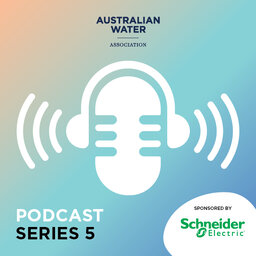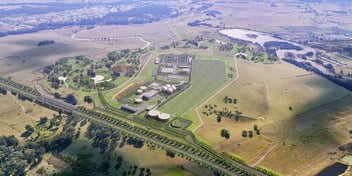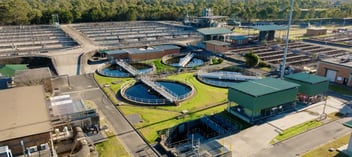Podcast – Beyond 2030 with Paul Higham of Sydney Water

In the latest episode of our United by Water podcast, host Jo Taranto sits down with Paul Higham (Head of Western Sydney Development at Sydney Water) to discuss Sydney Water's plans for a sustainable water future amidst a changing climate, a growing population, the ever-expanding Western Sydney region and incorporation of First Nations science.
Paul has spent almost 14 years working at Sydney Water across many leadership roles involving strategy, corporate social responsibility, assets, infrastructure and liveable city solutions. Paul joined Jo Taranto at Ozwater'23 last year to discuss the future of Sydney and water.
Listen below!
Paul, you've worked with Sydney Water for over 13 years, you must have seen some big changes in that time?
Certainly, the industry and the city has evolved a great deal over that period. I came over from the United Kingdom 13 years ago, Sydney water was ready for change and the city was evolving and the last 10 years or so have been exciting about how the new city will take shape out to 2050 and that's what the Greater Sydney water strategy is all about.
So, we're here to talk a little bit about that strategy for those who don't know anything about it, it's a New South Wales Government document, is that how it works?
Yes, it’s a document that's been released by NSW Government that looks at the long-term view and long-term vision of what water will be like for Greater Sydney. It's a 20-year plan with a 40-year vision and it's been done in partnership various agencies including the State Government, Department of Planning and Environment, Water NSW etc.
It’s not just thinking about a changing city, it's also thinking about a changing climate, is that right?
Correct, only do we live on the hottest, driest continent in the world, but we are now seeing the impacts of climate change, droughts and floods, our environment is changing around us. Our city is growing and the (Greater Sydney) population will grow [from] five million people to an excess of 7 million people and we will progressively move west as the city grows and expands.
How do you then bring a community on board when you're talking about a strategy and a changing approach potentially from a utility? You've got your existing communities, but you've got a whole bunch of new parts of the city, how do you engage and bring your community with you?
We’ve done an awful lot of work; we historically always have engaged with our communities. We’ve been going through deliberative forums and very broad engagement around what our customers expect and value from us as an organisation and as an industry. There’s a lot of conversations around not just the water supply that we get from the tap every day, 365 days a year, but what they expect from healthy waterways or liveability and greening. The growth of climate change is tricky because what are customers’ expectations around the role that we play in responding to and managing the consequences of climate change?
That rich feedback is coming out of very thorough engagement with our communities, and I assure you they're not shy of telling you what they want and what they aspire. What we've got to understand are what are the trade-offs to be able to achieve that? For our customers, long-term affordability is going to be key.
We already know that climate change is here. What does it look like when you are talking about water resilience and water supply and what is Sydney Water doing to respond?
Traditionally, our city has relied upon rainfall dependent sources, 85% of our water comes from Warragamba and other dams around the city. The desalination plant can also provide up to 15% of the city's water demand but as climate evolves and as climate changes, the reliance on rainfall is going to be harder.
The idea of building more rainfall dependent sources in a drought doesn't make logical sense in the long-term, particularly if the climate is going to get drier and hotter, so really thinking about how we plan for those rainfall independent water suppliers and considering all options like Purified Recycled Water (PRW) and engaging with the community on this as a viable solution. Is it something that they would accept in the long run? It’s practiced in 35 cities across the world.
Sydney Water has adopted a Net-Zero emissions target for 2030 there’s an ambitious circular economy program as well, what does it mean for Sydney water and its existing assets?
When we think about climate change, we think about two aspects.
- Adaptation - how do we adapt our existing infrastructure to respond to what other climate change will bring?
- Abatement is what is our role in actually supporting the change of managing the climate change as it evolves? When we talk about abatement, we're thinking about net carbon zero and what activities can we undertake to reduce our carbon emissions as an organisation.
We’re servicing a population of five million people with water every day and it’s quite an energy intensive operation, we must do the pumping, collection, sourcing, distribution and implement renewable energy sources including solar, wind, hydro and optimise these technologies.
Increasingly, the industry is acknowledging and respecting First Nation's connection to water so how is Sydney Water approaching this when it comes to planning?
We start with the position that our First Nations communities have been sustainably managing land and water for years and beyond. Through our Reconciliation Action Plan (RAP), we’re thinking about how we can bring that Indigenous knowledge into our planning, program, and processes. We must start internally initially with cultural awareness and getting people aware of what have the First Nations communities done and how do they think about the value of water?
We have close engagement with local Aboriginal land councils and language groups, and we asked them to participate in our asset planning to think about the cultural aspects to and the historic connection with Sydney. We need to make sure that we're considering the needs of those communities. We can learn from their experiences and embedding it in how we plan our infrastructure for the growing city is critical for the future it really does create positive value for us.
Thank you to Paul Higham and Jo Taranto.
This podcast is proudly sponsored by Schneider Electric




